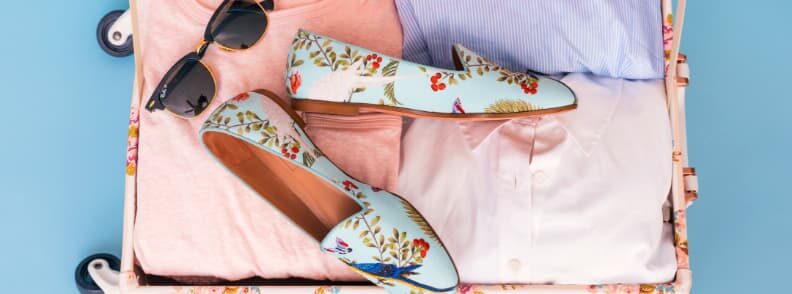There are so many reasons to choose carry-on luggage nowadays, from lower airfares to getting faster to your travel destination, and much more. However, many find it difficult to come up with a carry-on packing list on their own. That is because packing light is actually a skill you normally cultivate over time, through personal experience. However, through this travel guide, I will help you learn how to pack like a pro in no time!
This carry-on essentials guide will provide you with a checklist to use every time you travel light. It will also help you get comfortable and confident while doing packing your carry-on. Soon enough you’ll be teaching others your packing light skills!
Carry On Packing List To Travel Light

How I joined the carry-on travel club
Frequent fliers like myself have become experts at packing for a trip. We don’t even need to write down a checklist. We’ve mastered packing light so now we know by heart what to take and what not to take on a plane. I prefer packing on the day before I travel, but there are others who only take 10 minutes to pack a carry on for a week. One of them is Mathieu, my husband-to-be.
In the beginning, I wasn’t like this. I used to hate packing almost as much as I (still) hate unpacking. I never took days or even weeks to prepare my packing list, but packing my bags used to take me several hours at first. With time, however, I learned which are the essential travel items for packing a carry-on. These days, Mathieu and I often end up sharing a carry-on for travel of up to five days. And it’s not because of airfares, but because packing light and having only one carry-on bag gives us more freedom. We also realized we don’t really need to bring so many things in our luggage, to begin with.
So, to help you join the carry-on club, I’ve come up with this ultimate guide for packing light. It also comes with an all-purpose carry on packing list which anyone can use and adapt to their own needs. And I promise you: you’ll never forget your travel essentials if you use my hand luggage packing list. Read on to learn how to write your carry-on packing list!
But, first things first. Let’s consider the advantages and disadvantages of choosing a carry-on.
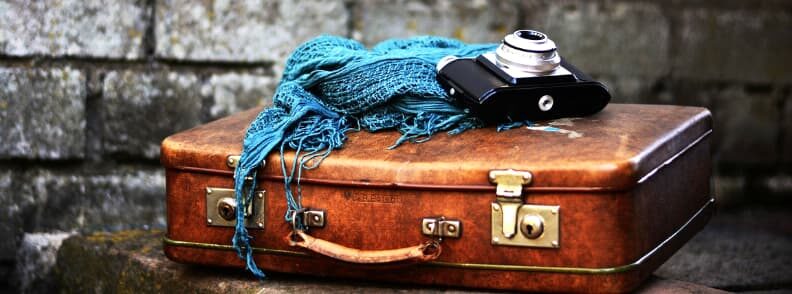
Should I bring a carry-on?
While bringing a carry-on has a lot of advantages, it also has some minuses. Here are some aspects to consider before deciding if traveling with hand luggage only is the best option for you.
What are the advantages of traveling with a carry-on only?
- Save money. You can make your travels more budget-friendly by choosing to pack only a carry-on. Airlines don’t normally charge you for storing luggage in the overhead compartment. And if they do, they charge you less than if you get your luggage checked in. Usually, with hand luggage, your end up spending less on your flight.
In addition, at your destination, the left luggage fees can also be lower, since most places will charge you depending on the size of the bag. - Save time. Security checks are fast if you learn to pack right. And, when you leave the airport, you can just take your carry on and go. There’s no need to wait for your luggage to appear at the baggage claim. You can get a faster connection from the airport to your travel destination and start visiting sooner.
- Save your strength. When you pack a carry on suitcase, it’s easier to take it up and downstairs, on buses, or on cobblestoned streets.
- Save your stuff. When it comes to safety, carry-ons have the upper hand. Checked luggage is often delayed, lost, damaged, or stolen.
I remember one time I was on a bus at Otopeni Airport when a suitcase fell from a luggage car while it was taking a curve. The driver didn’t stop, and I’m not sure if the owner ever recovered their luggage. Another time, I saw a poster offering a reward for a lost cat at the airport. I also heard many stories from friends whose luggage got put on a different flight to another destination or it was simply lost forever.
My experience with Air Serbia proved that things can easily get stolen even if they aren’t valuable. It also showed that checked luggage can be retrieved badly damaged. It’s just not worth wasting that much time with customer services trying to set things straight instead of enjoying your holiday.
Your luggage will also be safe at your hostels, as most carry on luggage fits in hostel lockers. - Save your nerves. When you travel with less, there are fewer things you need to remember to take with you.
- Save the planet. By traveling light you discover you can comfortably live with less. You will buy less stuff, you will choose solid eco-friendly toiletries, and you will use fewer resources, in general. In other words, packing light will help you discover sustainable travel.
What are the disadvantages of traveling with a carry-on bag?
- Little room for shopping. You can’t go on a shopping spree when you’re traveling with a carry on only. Sure, you may choose to deliver some of your stuff
home , but that may get lost, damaged, or stolen. - Limited clothing options. You pack with your holiday in mind, but this leaves out some spontaneity in mixing and matching your clothes. If you learn about an event while you’re at a destination, you may have to buy a new outfit.
- You have to cut down on your range of care products and the number of toiletries you bring. There are no such issues when you check your bags.
All things considered if you think hand luggage only is the way to go, let’s get down to the practical stuff. Learn how to prepare your carry-on packing list and turn you into a pro in packing your suitcase or backpack in no time!
How do I choose the right carry on bag?
The first thing to consider when choosing the right carry-on bag is the size. Normally, when you go to a specialized shop, you will see the same model in different sizes, usually three, and the middle one should be ok. But to avoid the guessing game in selecting the best hand luggage, I recommend you visit your airline’s website and read their baggage policy. Airlines publish the dimensions of carry on bags, as well as other rules you should find out before traveling.
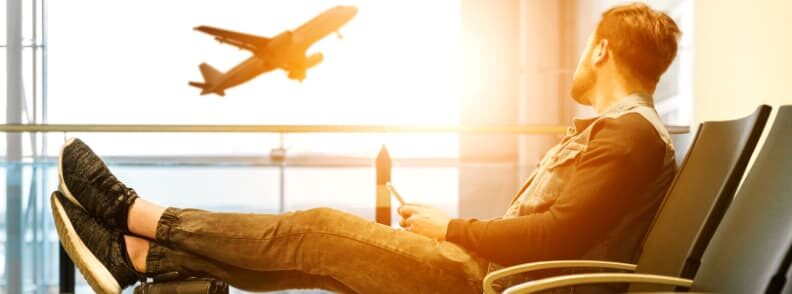
What airline carry-on rules should I research?
These are the main carry-on rules you should check on your airline’s website before working on your carry-on packing list:
- How many bags you can carry on your flight without additional fees
- What is the maximum size of luggage you are allowed to bring for storing in the overhead compartment
- What is the maximum weight for carry-on luggage
- If the weight limit applies to each bag or if it represents the total maximum weight
- If you are allowed to bring a personal item/personal bag at no additional cost. Most airlines will allow you to bring two carry-on items on your flight: one full-sized carry-on bag and a personal item/personal bag. However, it’s still a good idea to check your airline carry-on rules for this
- What type of things you can’t take on a plane.
Depending on how strict your airline carry-on rules are, you may need to adapt your carry-on packing list to respect their requirement.
It’s a good idea to weigh your luggage before you leave, to avoid any surprises at the airport. Use a portable luggage scale for more accuracy and stay well below the imposed airline weight limits. Better to be safe than sorry!
What is the best carry-on luggage?
The most important decision you have to make is the bag you carry. Depending on the type of traveler you are or the kind of trip you’re going on, what carry-on bags you need may differ from the best carry-on luggage for me or for other people. There are many brands out there and the aim of this article is not to promote any of them in particular, but to teach you how to best travel with a carry-on. Therefore, let’s go quickly on the types of bags that can pass as hand luggage to help you pick the right packing bag for yourself:
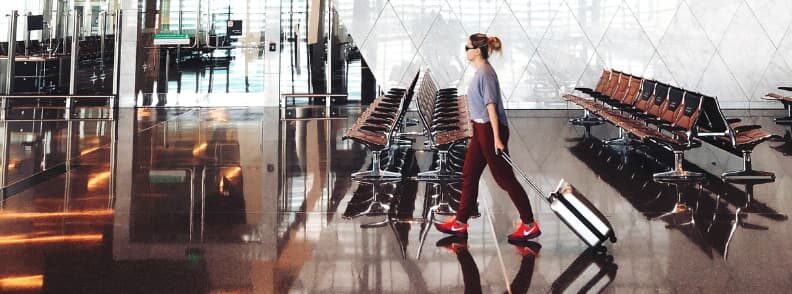
Rolling luggage
This kind of carry-on luggage is also known as a trolley bag and it’s what I most often travel with. If you choose the correct size of
How to choose the best rolling luggage
- Choose luggage that rolls easily. It makes it more convenient when you are dragging it behind you in airports, on paved roads or sidewalks.
- Choose four-wheeled luggage. While many pieces of luggage come with two wheels, look for those which have four wheels. In crowded places, you can keep it vertical on your side, not stepping on other people’s toes. It’s also easier to take tight turns with four-wheeled rolling luggage.
A major turn-off for rolling luggage is cobblestoned streets. Can you avoid them at your destination? If not, consider using a backpack as your carry-on luggage.
Duffel bags
Simple, and lightweight, they are easy to carry on your shoulder. If they feel too heavy, you can also look for a model that comes with wheels.
I tend to avoid them because they feel bulky in crowded places. When you take public transport to and back from the city, unless they are made from special anti-theft material, they are more vulnerable to thieves who use knives or razors to cut through the fabric. Also, if you have fragile objects, like some souvenirs for those at home, they are less shock-resistant. These are also some disadvantages to have in mind while traveling with a backpack.
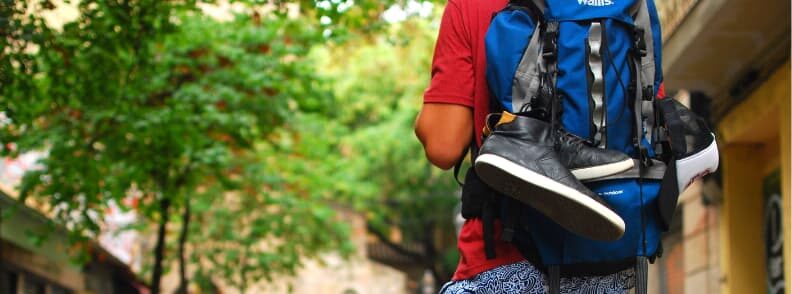
Backpacks
The main advantage of a backpack is that it offers mobility and it allows you to have your hands free while carrying your stuff around. It’s easier to have a backpack if you will have to carry your luggage on cobblestone streets or on several flights of stairs.
How to choose the right backpack
- Choose a durable backpack model. A backpack needs to pass the test of time, to be ready for wear and tear.
- Choose a comfortable backpack. The right backpack should not put any strain on your back. It should have wide shoulder straps which will not dig into your skin and two thinner straps that should go across your chest and around your waist to help you carry the weight easily. If the waist strap comes with some padding on the sides, it’s even better, as it will help you avoid painful chafing. It’s also best to make sure your backpack has a net between it and your back: not only it feels better on your back, but it lets you get dry when you sweat while carrying it.
- Choose a backpack that lets you easily access your stuff. Consider a front-loading backpack, which allows you to see the entire contents of your luggage with the opening of a zipper. Another option is selecting a backpack with multiple zippers for access. For example, I have one that provides access at the top, but also through the bottom, with a zipper inside the shoe compartment.
- Choose a rucksack with multiple compartments and pockets. This will help you separate your things based on how often you use them or on the type of items you brought along on your trip.
- Make sure your backpack offers options to strap things to it. From your sleeping bag to your flip-flops, it really helps to add some extra things to the exterior of the bag.
- Check that your backpack comes with a waterproof cover. Usually stored in a small pocket at the bottom of the rucksack, it helps keep your things dry during rainy or snowy days. Even if the rest of the backpack is waterproof, it’s best to have a cover with you, to extend the time it can be outside facing the elements.
As for the size, a 40 or 50-liter backpack should be fine as your carry on bag, in my opinion. If the length of your backpack is under 55 cm, you normally won’t get asked to check it and it will pass as a cabin bag.
For extra comfort, you could look for a model that also comes with wheels, though that usually means sacrificing some storage space at the bottom of the bag (either a larger pocket or extra strapping space).
No matter which type of carry-on you choose, keep this in mind:
Make your travels easier (literally!) by choosing a lightweight bag before working on your carry-on packing list.
In search of the perfect backpack to bring on your next flight?
Check out our Nayo Almighty review!
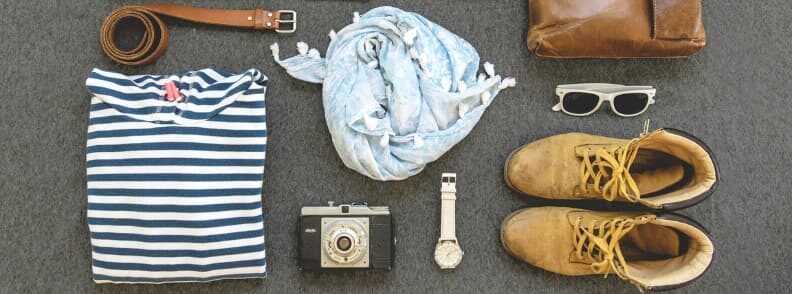
What is the secret to packing light?
Traveling light with a carry on bag comes with huge benefits, as we saw earlier. Therefore, learning how to pack your carry-on luggage wisely can save you a lot of money, time and trouble.
The first thing to consider is to pack only what you really need, what you will definitely use during your trip. I know many people are like me, and they like to always be prepared. However, that’s not an excuse for overpacking.
In many cases, it’s also useful to think about what you can buy at your destination and choose to bring only the things you definitely won’t find there. And buying things where you’re traveling to can cover a lot. For example, Mathieu went to Thailand for two weeks, did no laundry, and he bought underwear and shirts when we met in London. Other times, I met him on the weekend, brought him clean clothes for the next week and left with his laundry. In my carry-on luggage, where I also had my stuff as well, of course! So it’s good to always be practical when it comes to drafting our carry-on packing list.
Anyway, wherever we’re traveling, there are certain types of things we’ll be packing each time. And we’ll cover them together one by one below.
What should I add on my carry-on packing list?
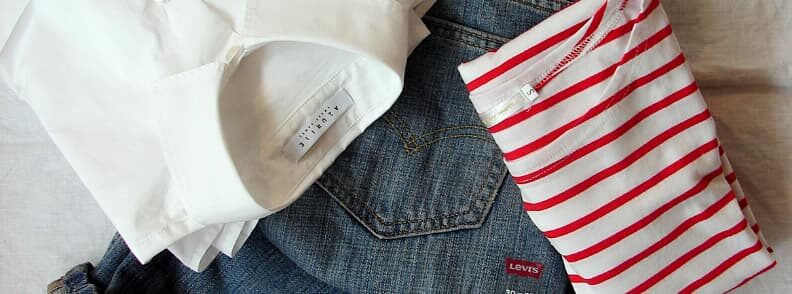
Clothes
In order to pack light, you should consider the length of your stay. And if it’s more than seven days, never pack clothes for more than a week. Consider using laundromats or check if the place you’re staying has a laundry service or a washing machine available. We’ll cover dirty laundry in detail a bit later, don’t worry.
Dress with purpose and efficiently prepare your carry-on packing list
Think long and hard about the type of holiday or trip you planned. Consider the activities you’ll be doing at your destination, and choose your clothes accordingly. Try to select clothes that can be easily mixed and matched. That way, you’ll travel with fewer clothes, but you’ll have more outfits to choose from.
If you’re planning to pack clothes that wrinkle easily, check with your accommodation if they have an iron or a steamer. If there is no such option, it’s best to leave such garments at home and select suitable replacements.
Another thing to leave at home? Most of your heavy/bulky clothes. They occupy a lot of space, and if you’re doing laundry they usually take a lot of time to dry properly. This can mean leaving with wet/half dry clothes in a bag in your carry on to your next destination or home instead of actually using them more than once on your trip.
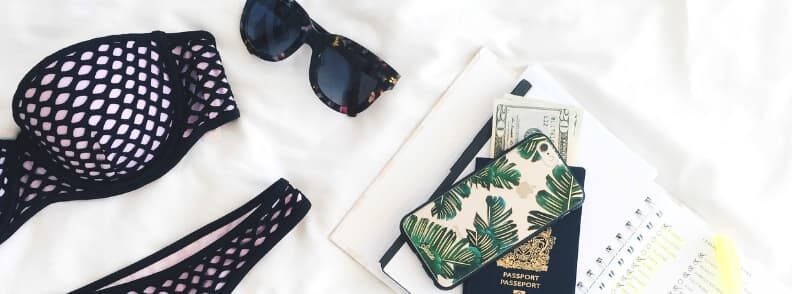
Dress for the weather
Another thing to consider when you’re drafting your carry-on packing list is what the weather will be like when you’re traveling to your destination. Here is a table comparing what to pack for cold weather vs. what to pack for warm weather:
| Packing for cold weather | Packing for warm weather |
| During days or periods with lower temperatures, you will sweat less, so this means you will be going through a lower amount of clothes. Clothes for cold weather tend to occupy more space from your bag. If you are going on an active vacation where you’ll be doing outdoor activities like skiing or snowboarding, you will sweat more, so plan accordingly to have enough spare clothes until the next laundry day. | During hot days or periods of time, you will sweat more, therefore you will need more clothes to change frequently into fresh ones. Clothes for warm weather tend to be thin, therefore they will occupy less space in your luggage. Add your bathing suit to the list if there’s any chance you’ll be taking a swim. |
Choose clothes which can be layered easily
It can be tricky to pack for early spring when you travel to most European cities. Although it looks warm when you look out the window, the sun isn’t that powerful yet, and in the shadow, you may feel quite cold. Or, it may be warm during the day, but very cold once the sun sets. This problem is usually solved by layering your clothes and having your top layer(s) on or off according to how the temperature shifts.
Wearing layers is also good during winter or in colder climates. You won’t spend all your time outside, you’ll probably go to heated places like a restaurant, a cafe or a shop. It’s best to be able to take the extra layers off to avoid sweating.
Layering your clothes is the equivalent of that always be prepared we talked about at the beginning of this blog post. It offers you a high degree of flexibility during your travels, without having to carry anything unnecessary with you.
Therefore, make sure you only pick clothes which can be layered easily. You can opt for different fabrics, but aim for a similar degree of thickness. It will feel less bulky when you have all your layers on.
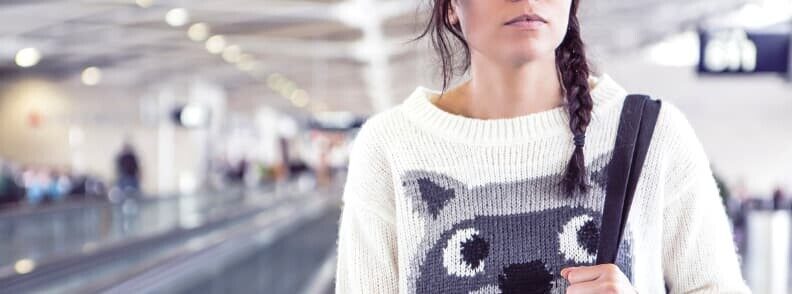
Wear your heavy clothes on the plane
If you do choose to take heavy layers with you, instead of adding them to your carry-on packing list, put them aside to wear on the plane. Here is a list of things you should consider wearing on the plane to avoid occupying space in your luggage:
- Jacket. Put it on or tie it around your waist.
- Heavy shoes. We are covering the shoes you should add to your packing list here.
- Scarf, shawl or sarong.
- Hat.
Not only is this trick going to save space in your bag, but it will also provide you with some useful items to keep you warm and comfortable during your flight.

Pack clothes which serve multiple purposes
Opting for versatile clothes and accessories offers you not only more outfits to choose from, but also more space in your luggage. You can repurpose that for other useful items to bring in your carry-on bag. Here are some examples of such items:
- A waterproof windbreaker. A light top layer on cold days, it can also come in handy in case it starts to rain. In other words, leave your umbrella at home! Just make sure you choose a hooded windbreaker. 🙂
- A
sarong , scarf or shawl. Whatever you choose to name it, it’s probably one of the most versatile clothing accessories out there. It can be a blanket or a headrest while you’re trying to sleep on the plane. And, as I’m sure you’ve seen in YouTube videos, they can be transformed in bags, tops, skirts, dresses and the list can go on an on. With a sarong or a large scarf, you’re only limited by your own creativity. In addition, you can get one that comes with a hidden pocket, where you can keep your phone, some money, or other small valuables on you safely.
To help with your inspiration, here’s a tutorial with 33 ways to tie a sarong:

Dirty laundry
Nope, I’m not saying you should leave home with dirty laundry packed in your carry-on bag. As I mentioned above, you should plan a carry on packing list with items for up to seven days, but not more. You can wash your clothes as you travel, taking advantage of local laundromats, or the laundry services/washing machines available with your accommodation. And I can assure you that the cost will be lower than getting larger luggage to fit more clothes in it.
To save space, don’t bring laundry detergent with you. Just buy a small, travel-size detergent pack at your destination. Remember what we discussed earlier: before adding something to your carry on, consider if it’s best to buy it after your arrival.
You may also hand wash some clothes during your trip. This not only saves you some money, but it may be the only option at times. Depending on where you are staying, you might want to consider a small clothesline to bring with you. However, if you’re in a hotel or an Airbnb, you can use the hangers from the wardrobe to dry your clothes.
To save time, you may want to make a long term investment in some quick dry clothes for your travels. There is a wide range of quick-dry clothes brands and models for you to choose from, whether you’re looking for tops, trousers, socks or underwear.
Here are some other advantages of quick-dry clothes:
- Quick-dry clothes let your skin breathe
- They are lightweight
- They don’t absorb sweat => They smell less! 🙂
Last but not least, you’ll want to separate your dirty laundry from your clean clothes when you’re packing your carry on bag. I suggest you keep the dirty clothes in a compression sack to occupy as little space as possible. We’ll talk more about compression sacks later.
If you are using a backpack as your carry on luggage, you can also put your dirty laundry in the sleeping bag compartment. That’s if it’s not already taken by your sleeping bag, of course!

Shoes
If you love shoes, then I’m sorry. My advice is to limit the number of pairs you’ll be bringing along in your suitcase. Having just one pair would be great, but it’s not always feasible. Therefore aim to take only 2 pairs with you on your travels.
As with the clothes, to pack a light carry-on you should consider where you’re going, when you’re going, and what you’ll be doing while you’re there. And, like before, the heavier apparel will be worn on the plane.
How to choose your travel shoes when you pack light
- You need shoes which are comfortable for walking long distances, with a sole that can absorb shock. This travel tip is good for outdoor activities, as well as for walks on those romantic cobblestoned streets for several days in a row. So keep this in mind if you’re planning a holiday in Rome or someplace similar.
- Your shoes should go with all your outfits. It’s a good idea to choose them in a neutral colour, unless all the outfits you packed have a certain dominant color.
- Your footwear should either be in a darker colour or easy to clean. They’ll be getting full of dust, maybe even mud if it’s raining or if you’re taking a walk on the lawn of a park or in a forest.
Speaking of rain, I suggest you look for waterproof shoes. It’s so uncomfortable and unsanitary to walk for hours with your feet wet! It’s even worse in winter, when your feet start freezing.
Should I add flip-flops on my carry-on packing list?
If you are staying in a cabin or a hostel or you’re traveling in summer, you should pack some flip-flops with you. They’re also handy when you have some doubts about how well your floor, shower or bathtub was cleaned before your arrival. And flip-flops are definitely a must-pack if you’re going to a spa or to a swimming pool.
They don’t take up much space in you carry-on. Just put them together with their soles facing each other and stick them inside a plastic bag. This way, you avoid getting anything else you packed in your luggage from getting dirty.
If you choose a backpack as
Discover rolled-up shoes
With a very thin and flexible sole, they aren’t suitable for all sorts of terrain. But they are comfortable, and they occupy very little space in your bag. You can look for rolled-up sneakers or even rolled-up flats.

Toiletries from your carry-on packing list
If you are staying in a hotel at your travel destination, you will most likely have shampoo and body wash (or a 2 in 1 formula) provided in your private bathroom. Therefore, you may not even need to bring these with you at all.
If you booked your accommodation with Airbnb, check the listing information again, as it’s usually mentioned whether you are provided with shampoo and soap. If it isn’t mentioned, you can also message your host to inquire.
However, if you know you know you need certain products for your hair and skincare, you should bring them with you. Just choose to pack their travel sized versions to save space and respect the flight requirements (under 100 ml).
Packing travel-sized cosmetic products
When selecting your toiletries, try to buy them in a travel size from the start. Or, even better, buy travel containers and simply fill them up with the products you usually use, from the big containers you have at home.
Such containers come as small boxes for creams and powders or small bottles with different types of caps fit for various types of products. You can buy them by piece or in a set. The advantage of sets is that they also come with spatulas and small funnels to easily transfer your toiletry products from your big containers to the travel-sized ones.
You can also opt for silicone travel bottles, which will take up even less room once you start using your toiletry products.
Stick labels to your travel sized containers to easily identify the contents.
Other toiletry items you should add on your carry-on packing list
Your toiletry products should be kept simple and essential, trying to reduce their number as much as possible. You may want to add:
- Small comb or brush. Consider investing in a travel brush without a handle/tail.
- Toothbrush, dental floss, toothpaste. Consider getting a foldable toothbrush perfect for a frequent traveler. Choose the smallest toothpaste tube you can find to add on your carry-on packing list.
- Deodorant. If you choose to also bring a perfume along, get a travel-sized version or, better yet, a sample of your favorite scent.
- A microfiber towel. Not only does it occupy very little space, but it also dries fast. You can also use it as a beach towel, or bring a separate one for when you’re at the beach. Once rolled up, it will definitely occupy less space in your carry on than a regular beach towel.
- Hair ties and/or bobby pins
- Feminine hygiene products
- Tweezers
- A razor.

Makeup to keep on your carry-on packing list
As far as makeup goes, let’s go with less is more, at least during our travels. There’s usually no need to bring more than a mascara and a lipstick. However, if you do need feel more comfortable wearing full makeup, consider this:
- Instead of foundation, choose a tinted face sunscreen that fits your skin tone. It serves as a face cream and as a light base for your makeup.
- Look for a 2-in-1 mascara tube: mascara at one end, eyeliner at the other. You won’t need to put both the mascara tube and eyeliner or pencil on your carry-on packing list, to.
- Get a makeup palette that can be used for your entire face, not just your eyes. You can do some research on YouTube to find some makeup tutorials on how to use your palette for full makeup. A friend got me Urban Decay’s Born to Run for my birthday and it’s great for travels, though I don’t always bring it along.
- Pack lipstick or tinted lip balm instead of lip gloss. Choose a solid product over a liquid one to add to your carry-on packing list.
To clean up your makeup, don’t invest in disposable makeup remover wipes or makeup remover and single-use discs. Instead, choose a facial cleansing towel or reusable makeup remover discs. You can just use them with water to remove your makeup, and when they get dirty you can simply give them a wash and use them again. Yay for sustainable travel options and saving money, too!

Get solid toiletries to avoid flying with liquids
Whenever possible, I suggest you replace liquid toiletries with their solid versions. This will not only save space, but it also reduces the risk of liquids spilling and making a mess in your suitcase or even damaging what you chose to pack.
Here are some liquids which you can replace from your carry-on packing list:
- Shower gel. Easily replaced by a small bar of soap. You can opt for a hydrating soap to not have dry skin after your showers. And, if you’re using a good creamy soap you can even skip on bringing any body lotion, too.
- Shampoo. Did you know there are solid shampoo bars? They’re like soap, only for your hair. Adding solid shampoo bars to your carry-on packing list comes with several advantages: they save space in your luggage, they last for a very long time, and they’re environmentally friendly. And if you really want to take just the essentials with you, you can also use it as a body soap.
- Conditioner. Like with shampoo, there are also solid conditioner bars, if your hair needs a bit of extra care.
- Deodorant. Choose a solid natural deodorant that takes care of your skin while protecting you against strong body odor. It’s also environmentally-friendly!
- Toothpaste. Toothpaste also comes as a powder and one container lasts for a very long time.
- Sunscreen. Yup, you can get sunscreen sticks to protect your skin during your travels, be it summer or winter. A major advantage is that stick sunscreen is way easier to apply evenly on your body. It will also feel less oily on your skin.
- Insect repellent. You can buy mosquito repellent bracelets from your local drugstore to avoid getting bit.
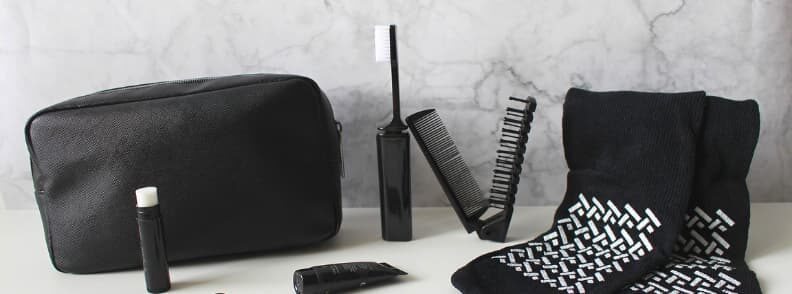
How to better store the toiletries from your carry-on packing list
To better store your toiletries even after you unpack your carry on, I suggest you buy a hanging toiletry bag. This is extremely useful when you’re staying in a place with a small bathroom or in a hostel with a shared bathroom.
This toiletry bag holds everything you need in one place and you can just put it on a hook, hang it on the door handle or hook it to a pipe near the shower. Some hanging toiletry bags are waterproof and you can even bring them with you in the shower.
Remove liquid toiletries and put them in a transparent resealable bag. This will go in your personal bag until you reach your destination, to go through the security check faster. After your flight, you should move them to your hanging toiletry bag or directly to your bathroom.
We still have to go through medicine, electronic devices, and important documents. These, however, should go in the bag that you will be taking as a personal item. If you are not allowed a personal item, add them inside your carry on bag, but in different pockets/satchels, for easy access and safety.

How do you efficiently pack a carry-on only?
Here are some travel hacks that you can use when you’re wondering how to pack more efficiently:
- Use packing cubes. In different colors and sizes, packing cubes can help you sort your belongings by category. You can have a cube for tops, one for bottoms, and one for underwear. When you open your suitcase or backpack, you can choose what you need easily, without the need to unpack everything. Packing cubes are great for more organized packing.
- Try compression bags. Taking out the air from between your clothes can save a lot of space, allowing you to pack your carry on more efficiently or, if you’re feeling brave, to switch to even smaller hand luggage. Compression bags are extremely useful for packing winter clothes without using too much space or to keep your dirty laundry in them.
- Use all the available empty space. If you still chose to pack some footwear in your carry on bag which isn’t rolled-up shoes, store your socks inside them.
How to pack clothes more efficiently
If you’ve been reading travel blogs or other guides on how to efficiently pack your carry on, you probably learned that rolling your clothes is the way to go. I think it’s the most basic tip for traveling light. And in most cases, it works fine: it saves space in your carry on and it keeps your clothes from creasing.
But some clothes don’t handle rolling too well. Clothes from rougher fabrics, and dresses or bottoms should be folded. However, I think it’s best if I tell you a little about each popular efficient packing method, and you can choose what works best for you on your own:
The Army roll
The Army roll is an improvement to the classic roll (rolling your clothes the best you can). It helps you roll your clothes as tight as possible, with a clean finish that prevents them from unrolling. Here’s a tutorial for the Army roll packing method:
The Skivvy roll
To take things even further, you could try the Skivvy roll: put your underwear inside your shirt, roll them up and stick them in your socks. Here’s a tutorial on packing a Skivvy roll, with an extra travel tip on hiding stuff valuable to you inside it:
I have tested this out, but I think Skivvy rolls end up being too bulky, especially in the colder months.
The KonMari packing method
I have to admit that this is currently my favorite packing method. Marie Kondo’s folding style is somewhere between classic folding and rolling. The clothes are really easy to find and your carry-on is super-organized all the time during the holiday. Here’s how to KonMari your carry on:
While I wouldn’t put my hat inside the carry-on bag, the rest fits me perfectly. In addition, I already have all my clothes folded in the KonMari method at home so it’s extremely fast to select what I need and add it to my carry-on packing list.
Bundle packing
Bundle packing is also promoted on YouTube. It can work if you’re traveling to only one place and once you get there you put everything tidy in the wardrobe. However, if you’re on a road trip, sleeping each night in a different spot, only the thought of opening this up gives me a headache:
Extra tips for efficiently packing your carry-on bag
- Depending on the bag you’re taking with you, the folding style that offers you the most space can be different. Try several options the first time, and then you’ll know what works best for packing your carry on luggage efficiently.
- Sometimes you can make more clothes fit with minimal folding. Try that, too.
- You can organize your suitcase even more if you use the KonMari packing method with narrow packing cubes.
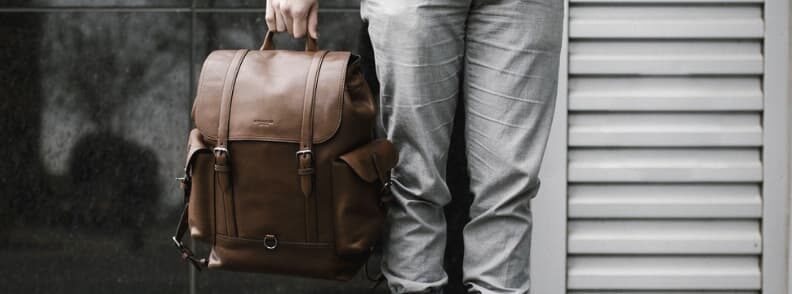
What can you take on a plane as a personal item?
A personal item is a small bag, smaller than
To avoid carrying too many bags with you, your personal bag should be the one you intend to use as an everyday bag at your destination. A day backpack which is versatile is the best option. Another good option is a cross-shoulder bag.
To save time during the security check, you should keep your liquids and gels in a resealable transparent bag in your personal bag. It’s easier than opening your carry on, taking the liquids bag out for the security check, then putting it back in the larger luggage.
For safety reasons, your
For your comfort, anything else you may need to use during the flight should be within arm’s reach, thus inside your personal bag. Frequent flyers know to always be prepared by packing necessary items in their small cabin bag.
If you thought packing your carry-on was a difficult task, making everything fit in the personal item is even harder. Luckily, you’ve already got some training now, and have even more packing tips specific for your personal item.
How to better pack your personal bag
If you are bringing a camera or a laptop with you, instead of wasting your personal item allowance on a dedicated bag, try to fit them in your personal bag.
It’s also a good idea to choose a personal item with lots of pockets to easily store the remaining things, namely your medicine, electronic devices, important documents and some things to take on a plane to make the time spent in the air more enjoyable.
What to pack in your personal item

Electronic devices to add to your carry-on packing list
LiPO batteries turn electronic devices into a fire hazard. Therefore, for flight safety reasons, such electronic devices should always stay in your carry on luggage. Better yet, in your personal item.
Nowadays, it’s difficult to imagine traveling without any electronic devices whatsoever. While an endangered species, these people still exist. I’ve met only one during my travels, he didn’t even use a phone, not even when he was at home. No camera to take photos, just enjoying the moment and keeping his memories in his heart. It may sound ideal, but let’s face it: it’s probably not us.
Most travelers have their phones, which they also use as a camera and as an e-reader. They may even watch movies or their series on it during the flight, while others choose to pack a tablet or a laptop solely for this purpose. And there are those who really need to bring a laptop along for work because not all trips are holidays.
Some people really do bring a lot, but not necessarily for overpacking. I remember being stuck in the
I don’t want that to be you. So whatever you need to bring along, here are some tips for adding your electronic devices to your carry-on
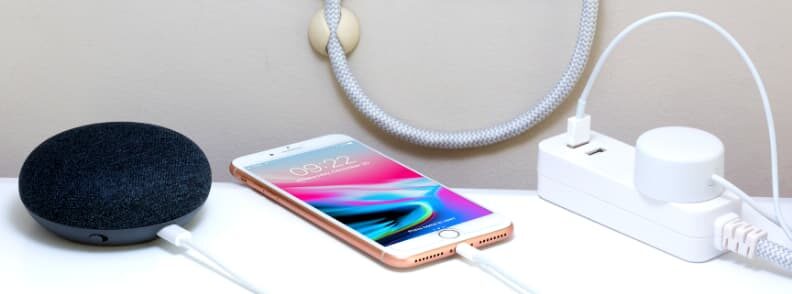
How to efficiently pack the electronic devices from your carry-on packing list
- Use a wire
organizer . A wire organizer will keep your cords easy to find, untangled, and occupying as little space as possible. - Use velcro cable ties around your wires when necessary. It makes it easier to pack and unpack often.
- Add an international adapter with multiple USB plugs to your carry-on packing list. Most of your devices (if not all!) have cables for charging via USB. Using an adaptor with multiple USB plugs saves room and time, as you can charge all your devices at once. A universal adapter fits the plugs of most of the countries you will travel to and should also convert the various electrical currencies.
- Put an extension cord or at least an extra-long charging cable for your phone on your carry-on packing list. Sometimes, the room you’re staying in doesn’t have the plug sockets where you need them to be (e.g. next to your bed), so an extension cord or a longer cable can help you avoid uncomfortable situations.
- Add a portable power bank to your carry-on packing list. An external charger is also useful to carry with you on a daily basis when you travel. When you’re using electronic maps or travel apps, you don’t want to run out of battery in the middle of the day. Or, even worse, to get lost.
Fully charge your electronic devices before your flight
You never know if you can charge your devices at the airport. The airport charging stations may be taken, they may not work or they may even not be there at all if you’re in a smaller airport. You can’t always count on your plane having a USB plug in the armrest either. Even with the same airline, some planes have it, others don’t.
Therefore, always make sure you fully charge your electronic devices before you leave home so you don’t run out of battery. A power bank is also useful if your device runs out of battery fast or you use power-intensive apps.
If you want to stay entertained during your flight, download ebooks, movies, series, and/or music to your smartphone, tablet, or laptop.
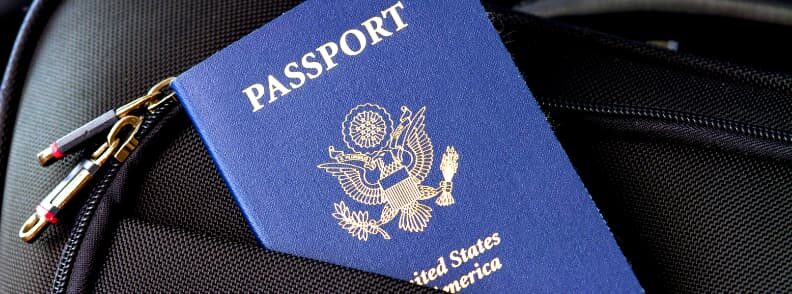
Important documents and valuables for your carry-on packing list
Before your flight, prepare printed copies of your important documents and add them to your carry-on packing list. Here’s what to travel with you:
- ID and/or passport, plus visa, depending on where you’re going. You might want to also have a copy of your driver’s license or sailing permit, if available. In some countries, you also need passport photos provided separately. If you are a student, take your student ID, too, as you may be eligible for discounts at museums and other attractions.
- Boarding pass. While mobile boarding passes are often used nowadays, it’s best to also add a printed copy to your carry-on packing list, just in case your internet connection isn’t working.
- Printed full itinerary. Some countries need you to present proof that you are going to leave once you’re done visiting things. Therefore, it’s best to have a copy of your full itinerary in your important documents, plus some other evidence that you’ll be leaving the country (e.g. your return flight ticket).
- Printed tickets. This includes tickets for pre-booked airport transfers or tourist attractions.
- Printed accommodation address and booking details.
- Credit and/or debit cards. It’s useful to have copies of your credit and/or debit cards in case they get stolen. You can easily check the numbers on the back to act fast and call to get your cards canceled.
- Health and travel insurance
- Emergency contacts.
It’s a good idea to also make digital back-up copies of your important documents, too. These can be stored on your phone, a USB drive, an SD card, etc. So remember to add these to your carry-on packing list, too.
You should also make sure a family member or close friend also has access to copies of your important documents in case of an emergency.
How to safely pack your important documents when you travel
It’s vital to keep all your important documents on you or close to you. If you have the option of keeping them in a hidden pocket or pouch on you, then do that. If not, choose a hidden compartment in your personal item for keeping your important documents safe when you travel.
All your valuable items should always be packed in your carry on luggage, preferably inside the personal items. This applies even when you check some of your bags. This way, you avoid stealing, damaging, or losing the valuable items you choose to travel with.

Medicine kit for your carry-on packing list
While you may want to invest in a small first aid kit, you can also create one from scratch, fit for your personal needs. Here are some things you may want to add to your carry-on packing list:
- Bandaids and bandages for getting bruised / cut, or getting blisters.
- Hydrogen peroxide. A small bottle, packed with your liquids, to use as
disinfectant . Ibuprofen / something else for mild headaches- Immodium / something else for upset stomach
- Wide-range allergy medicine (or specific to your known allergies)
- Any prescription medicine, like antibiotics and birth control pills, plus your prescriptions
- Any other regular medicine you may be taking, if any.
If you wear contact lenses, pack a travel-sized lens product, too. And it would be a good idea to bring glasses and another pair of fresh lenses as a backup, as well.
You can pack all your medicine in a transparent ziplock bag and place it in an easily accessible pouch or pocket of your personal item. Make sure your liquids and gels are packed separately in the transparent resealable bag, and that they are in containers under 100 ml.
Label your medicine to easily identify it, but also to save time during security check, should they want to inspect your medicine kit.
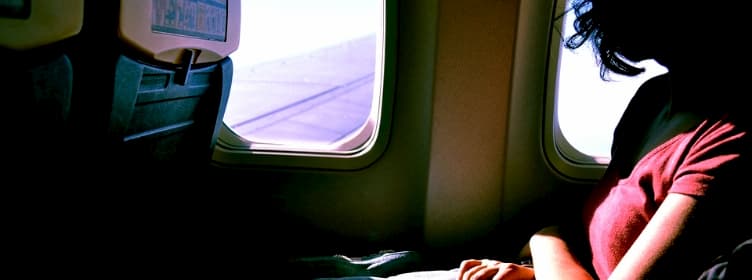
What to take on a plane to increase comfort
To be more comfortable during your flight, you should consider adding these to your carry on packing list:
- Earplugs. If you have headphones or earbuds which are noise canceling, you can use them to serve a double purpose.
- Eye mask. If you need it to be dark around you in order to sleep on a plane, you should consider adding an eye mask to your hand luggage packing list.
- Scarf or sarong to use as a
blanket . Make sure you put it on you under the seat belt. This way, flight attendants can check you have your seatbelt on without waking you up. - Inflatable travel pillow. While a memory foam travel pillow is a lot more comfortable during the flight, it’s more inconvenient to have around before and after your flight. Sometimes you may even carry it for nothing, as you might not use it during the flight at all. Therefore, an inflatable travel pillow is the best choice to add to your carry-on packing list
- Collapsible water bottle. Occupies very little space when empty. You can fill it after the security check with tap water, and it will save you a lot of money over time. Please check in advance if the airport water or the tap water at your destination is drinkable. If not, cross this off your carry-on packing list.
- Antibacterial wet wipes. Did you know that the food tray tables have the most germs on the plane? Even more than the flush button of the plane’s toilet? You should check out Travel Math’s report on airline hygiene.
Ear plugs and eye masks are also useful after your flight, in case you are staying in a shared room or a hostel with a late curfew (if any). Might also come in handy if you chose to book your stay somewhere in a busy city center where it’s loud even after midnight.
Ever heard of SleepPhones? It’s a headband that keeps your earphones in place while you sleep, acting as a sleeping mask at the same time.
You can skip the travel pillow completely and use your scarf or sarong as a pillow, if you’re dressed warm enough for the plane.
Congratulations on packing your carry-on luggage!
To recap, packing a suitcase is a skill, and with my ultimate guide to making your own carry-on packing list, you will master it faster. You will save money, and you will go through the security check fast. When you’re packing your carry-on and going to the airport, I want this to be you:
I hope you found my carry-on packing list helpful for your next trip. Please share this article with any of your friends who may be struggling with packing light when they travel.
About the author

Mirela Letailleur is a Romanian travel blogger living in the South of France. She writes on The Travel Bunny travel blog about affordable travel in Europe, creator of unique free travel guides, local travel expert. Problem solver. Wannabe coffee guru.
More carry-on packing list tips for savvy travelers
How to avoid extra baggage fees
How to pack checked luggage the right way
Avoid missing luggage and other baggage problems

